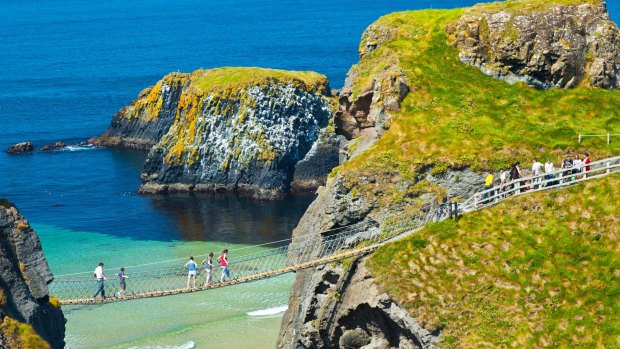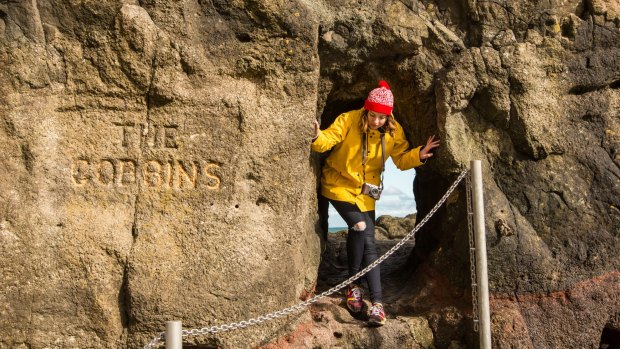This was published 6 years ago
Northern Ireland's Gobbins Cliff Path is one of the world's greatest walks
By Liam Phelan

At Carrick-a-Rede you can test your bravery by walking across a short rope bridge to the small island used as a launch site by salmon fisherman in centuries past.Credit: Alamy
This journey starts with angry fairies and ends with a magic hill. They're linked by one of Ireland's greatest drives – a spectacular coastal road trip that takes you north from Dublin to the Giant's Causeway, via Belfast and the Mourne mountains. Along the way you encounter history, adventure, music, culture – and fried bread. Lots of fried bread.
But first to the fairies. When Northern Ireland's Gobbins Cliff Path reopened in 2015 at a cost of £7.5 million, there were high hopes for a tourist revival of the Edwardian-era attraction billed as "the most dramatic walk in Europe".
Built and designed by innovative Irish engineer Berkley Deane-Wise, the three-kilometre Gobbins path is located on the peninsula of Islandmagee in Country Antrim. The path drops steeply from the clifftop and takes you to sea level, where you pass through a carved giant keyhole entrance in the rock known as Wise's eye. From here you travel along the base of the cliffs by way of a series of metal bridges and walkways. At one point you even go "underwater" as you crouch through a crack in the rock and clatter along a metal walkway with sea water on both sides. You hear the rasp of "dragon's breath" just outside the entrance to the fissure (or waves being forced through a blowhole for the more scientifically minded).

The Gobbins Path is a wonderful walk, with the might of the ocean rumbling and crashing beneath your feet. Credit: Tourism Northern Ireland
It's a wonderful walk, with the might of the ocean rumbling and crashing beneath your feet as you lean into the cliff and clamber over tubular bridges and metal walkways. You can see colonies of sea birds including kittiwakes, razorbills, guillemots and Ireland's only mainland colony of puffins, a bird that looks like it was designed by a clown. The day we visited, dolphins dipped in and out of view in a roiling green sea.
In 1903, a year after the path opened, Sydney newspaper The World's News described it thus: "Strong but wonderfully delicate bridges of iron stretch across the foaming water." But after its initial success, the path slowly fell into disrepair and was closed by the 1950s.
Thanks to an investment by the council it was back in business in 2015. And that's when the trouble with the fairies started. According to guide Jill Maxwell when the path first reopened it took visitors right past a fairy tree, a stunted hawthorn that people decorated with ribbons and pierced with coins. Within months, the track was washed away, forcing the path to close. Was this the might of nature, driven by Storm Frank – or the wrath of fairies outraged at having their home loved to death? Maxwell won't say, but happily for visitors the path has now been rerouted further south, and Gobbins is back in business.

The walk fell into disrepair but reopened in 2015.Credit: Tourism Northern Ireland
To access the path you have to book via the Gobbins visitor centre, and you get a guided walk that takes about 2½ hours. The visitor centre itself is well worth a look around, with a cafe serving soup, sandwiches and homemade cakes that seem to magically disappear after you've worked up a fierce appetite clambering up and down the cliffs.
To get to Gobbins from Dublin is only about a three-hour drive. But rather than go direct, you can make it part of a multi-day road trip, going via Carlingford Lough and the Mourne Mountains.
Coming from Dublin, this is the start of your coastal trip. Turn off the N1 just past Dundalk on to the R173 for Carlingford. You're now off the main road and your meandering jaunt along the coast begins. It's time to slow down, enjoy the scenery and get ready to explore picture postcard villages that pop up with pleasing regularity.
As well as being geologically significant – the lough is one of only three glacial fiords in Ireland – this shallow body of water is a political divide. On the southside you are in the Republic of Ireland, with its Cooley mountains, Tain walking tracks and sleepy villages of Carlingford and Omeath. On the northern shore you are in Northern Island, with its backdrop of the Mourne mountains, and slightly less sleepy towns of Rostrevor, Warrenpoint, Kilkeel and Newcastle. But here's the point. The land on both sides is the same; the hills are the same. But it's a shock to suddenly see Union Jacks pop up on the northern shore rather than the tricolour green, white and orange on the south side. You also notice a marked change in accent. In County Down, north of the border, they speak a brand of English that sounds like they've swallowed a gobful of coarse marbles. Every syllable seems to have been ground down and spat back up, so even the name of the country ends up as "Norn Iron".
The Cooleys and the Mournes are great walking areas, the latter holding an annual walking festival. For the musically minded, the famous ballad Mountains of Mourne, written by Percy French in 1896, is still sung in bars throughout Ireland.
Once past Newry, follow the signs for the Mourne Coastal Route.This takes you through Kilkeel, Annalong and Newcastle. If the weather allows don't miss a sidetrip to Spelga Dam, in the heart of the Mournes. The lake makes for a great photo stop and you can hike up any of the nearby hills, including the challenging Slieve Muck. Keep an eye open for the Mourne wall, Ireland's answer to China's Great Wall. If the weather isn't great, you can head for Silent Valley Mountain Park, which has a range of mapped walks through forest, an interpretative centre and a cafe in case of downpours.
We stayed in the Burrendale Hotel Country Club and Spa in Newcastle, which is a good halting point for day one. For golfers the hotel is beside the Royal Country Down Golf Club. For gym junkies there are a host of free fitness classes where incomprehensible commands will be cheerily shouted at you by local fitness instructors.
The next day, after a food coma-inducing "Ulster fry" (sausages, bacon, eggs and three types of fried breads including potato and soda bread) we drove to Belfast for a quick taste of city life.
Northern Island has just been named as the world's best food destination and its capital won the honour of Lonely Planet's best place in the world to visit in 2018. We stayed in the newly opened Grand Central hotel, an upmarket high-rise in the heart of the city within easy access of City Hall and the not-to-be-missed Titanic Museum, voted the world's leading tourist attraction. You can try a black cab tour that takes in the city's political murals and peace lines (separation barriers) from The Troubles, a bloody period of recent history that pitted Unionists against Republicans.
The next day it's time to get back into potter mode. Take the main road north out of Belfast and look for the turnoff for the Causeway coastal route, a 246-kilometre drive between Belfast and Derry that takes in the Gobbins Path, Carrick-a-Rede rope bridge, Rathlin Island and the landmark World Heritage Site of the Giant's Causeway. You are about to enter Games of Thrones territory so keep your wits about you.
If you have the time it's well worth a day trip from Ballycastle to Rathlin Island. The L-shaped island is only a 25-minute boat trip on the fast ferry and has three lighthouses (including one that's "upside-down"), great walks, a pub and a visitors centre. When we visited the centre was closed but a helpful local told us about ancient celtic stones just above the main harbour, a mini Giant's Causeway and a small bay popular with sunbathing seals. Between April and June is puffin season on the island.
An American who was a bit more efficient than we were marched off and missed all of the above. Perhaps this was a lesson in the need to slow down and talk to locals. Some of the best history and nature spots in Ireland are unmarked so it's really worth having a chat with everyone you come across, even if sometimes you might only catch every third word they say.
The island is proud of its links to 14th century Scottish king Robert the Bruce and the local legend of how he watched a spider repeatedly try to spin a web, thereby coming up with the maxim: "If at first you don't succeed, try and try again."
Back on the mainland, it's a short but spectacular hop from Ballycastle to Carrick-a-Rede, where you can test your bravery by walking across a short rope bridge to the small island used as a launch site by salmon fisherman in centuries past.
Just north is the village of Ballintoy, with its medieval harbour featured in Game of Thrones. We spend a cosy night in the Fullerton Arms Hotel. The bar has great seafood and meat but get in early as it can get busy, even midweek. If you're game take a seat on the Iron Throne.
From here, we set off for the short drive to the landmark Giant's Causeway, 40,000 hexagonal-shaped basalt pillars, which date back to a volcanic age almost 60 million years ago. That's the science. But, of course, in Ireland there's always a folk story, too. According to mythology, Irish warrior Fionn mac Cumhaill built the causeway as a bridge to Scotland to fight a rival. To hear the full story takes time, and maybe even a drop of uisce beatha (water of life), the Gaelic name for whiskey. By coincidence you are only a stone's throw from Bushmills, Ireland's oldest licensed distillery, which offers visitor tours and tastings.
The Causeway coastal route continues on from here past the spectacular ruins of Dunluce Castle, the towns of Portstewart and Portrush (home of the 2019 Open Golf championship in July) and on to the walled city of Derry-Londonderry. But unfortunately for us, this is where we leave the coast road as it's time to make our way back to Dublin.
On the way we popped back to Spelga Dam, where we were told about a magic hill, again by chatting with a local. Known in Scotland as an "electric Brae" you drive you car "down" a short incline and can then watch it roll back uphill. Magic? The fairies? You'll have to visit Northern Ireland and decide for yourself.
TRIP NOTES
Liam Phelan travelled to Northern Island courtesy of Tourism Ireland.
MORE
FLY
Emirates and Etihad fly to Ireland daily, with one stop in the Middle East. See emirates.com ; etihad.com. For car hire, Enterprise Car Hire. See enterprise.com
STAY
In Newcastle see Burrendale Hotel Country Club and Spa; in Belfast see Grand Central hotel; in Ballintoy see Fullerton Arms Hotel
VISIT
The Gobbins Cliff Path is called "the most dramatic walk in Europe". See thegobbinscliffpath.com
Sign up for the Traveller Deals newsletter
Get exclusive travel deals delivered straight to your inbox. Sign up now.